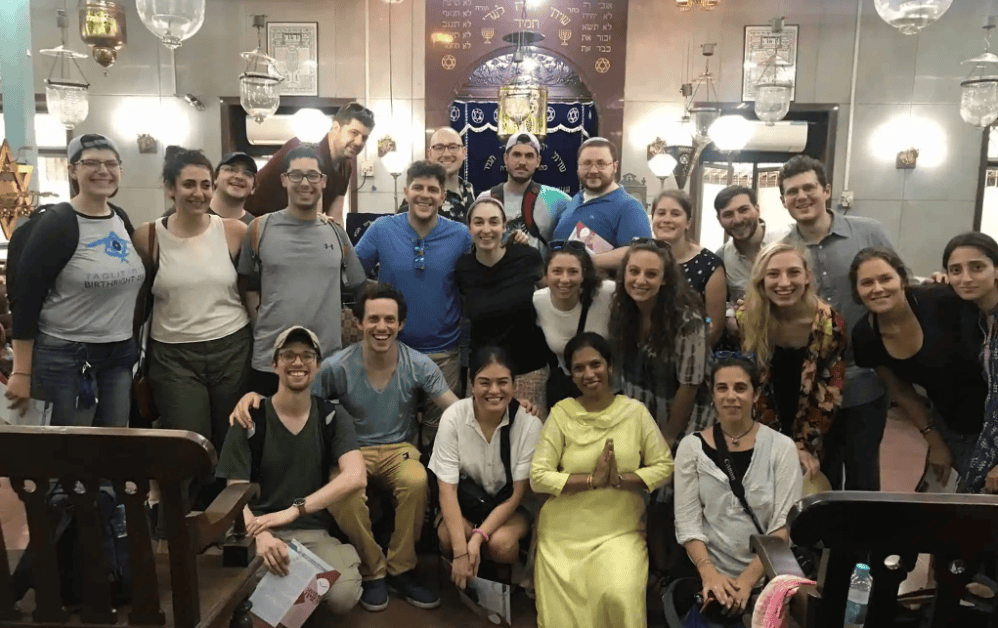Individually Together
posted September 23, 2024 by Rabbi Josh Mikutis

With beads of sweat dripping off my forehead, I sat in one of the remaining synagogues in Cochin. I was in southern India, leading a group of rabbinical, cantorial, education, and non-profit management students from Hebrew Union College-Jewish Institute of Religion (HUC-JIR) as part of the Weitzman-JDC Fellowship. We had planned to have Jason, one of the students, lead mincha, the afternoon service, and I delicately asked that he speed things up — I was worried that trip participants would start passing out. We had joined Jewish Youth Pioneers (JYP), a JDC-supported group of young Indian Jews, for their summer retreat, and they sat with us as well.
Despite the significant differences between our two groups, we bonded in this moment of shared prayer. Some of the tunes we had used were unfamiliar to our Indian hosts, but the words of the Amidah, the central prayer of liturgy, were shared by us both. After Jason concluded his prayers, one of the members of JYP asked if he could say the Hashkava, a traditional Sephardic memorial prayer. For our overwhelmingly Ashkenazi group, this was as unfamiliar as our Debbie Friedman tunes were to the JYP members. Most of us were unacquainted with this ritual — and yet, the words and cadence were familiar.
Prayer is a peculiar force in Judaism. On one hand, it represents that which we all have in common. We all say the same Shema — whether in Chicago, Cochin, or Casablanca. And yet, it shows where we diverge. Go to almost any Jewish conference, and the list of prayer options will be comically long. We sing the same songs, but we sing them differently.
The liturgy of the High Holidays demonstrates this same paradox — we alternate between intense unity and extreme individuality. Two prayers represent this divide: the Hineni prayer offered by the prayer leader during Rosh Hashanah Musaf and the Vidui, confession, recited by the entire congregation in the plural.
Hineni is a rarity in Jewish liturgy for its individuality. The prayer leader intones: “Behold, I stand here, impoverished in good deeds, perturbed, and frightened.” It is an astonishing piece of vulnerability: the figure, meant to carry the burdens of the people she is praying on behalf of, plaintively admits anxiety about the task ahead. She continues, “May they not be ashamed of me, nor may I be ashamed of them.”
The leader is in direct relationship with the people — but there is clear separation. She is responsible for what she has done, just as they bear their own responsibility. And though she has been called to lead them in prayers, her faults or deficits should not reflect poorly on them. To borrow the words of the great liturgical poet Paul Simon, she is a rock, an island.
On the other hand, the Vidui represents the opposite. “Ashamnu,” the congregation recites in unison, “we have trespassed; bahgadnu, we have betrayed; gazalnu, debarnu do-fi, we have stolen, we have slandered.” The confessional continues where we list our collective sins in excruciating detail: al chayt shechatanu, on account of the sin we have committed. There is something strange about admitting to sins that we personally have not committed, but something powerful about joining the multivocal confession.
It does not matter if we individually did not commit a particular sin, because we as a collective are responsible for each other. The phrase that defines so much of JDC’s work — kol yisrael arevim ze le’ze, all of Israel are responsible for one another — generally refers to our responsibility when other Jews are sinning. For better or worse, we are not islands; rather, we are all on the same island together.
When our two groups in Cochin shared our different prayer practices, it was a powerful display of simultaneous Jewish unity and diversity. There are times when we speak as individuals and times when we speak as a collective. It is not “either/or” but “both/and.” One of the beauties of Judaism is when we can marvel and appreciate both what binds us together and what sets us apart.
We have so much to gain from embracing moments of collectivity;. And when together, we can also celebrate those things that make all of us unique. It’s in this back and forth, between collective and individual, that we continue the Jewish experience into a new year.